Excerpts from Jim Conrad's
Naturalist Newsletter
entry from field notes dated May 7, 2023, atop hill forested with pines and oaks about 1km east of Curva de la Doctorcilla, on unnamed road connecting Hwy120 and El Doctor; limestone bedrock; elevation ±2650m (8700 ft); Eastern Sierra Madre mountains of east-central Querétaro state, MÉXICO, (N20.88°, W99.62°)
QUERCUS X DYSOPHYLLA
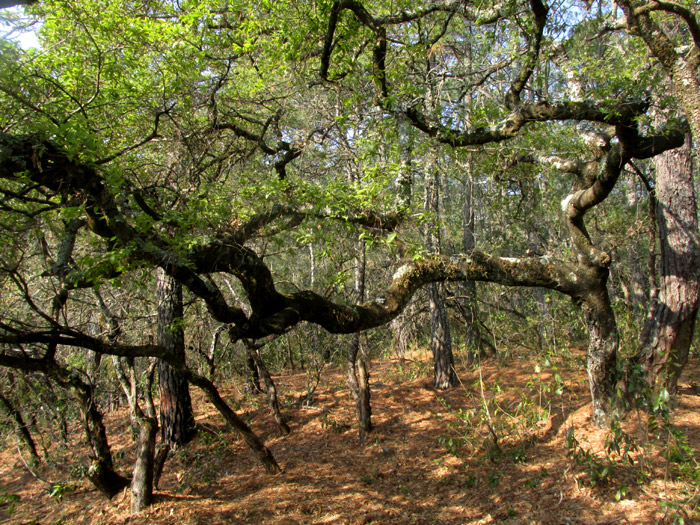
Atop a hill the above tree had spent its life searching outward for light, having sprouted right beside a pine tree which, judging from its trunk's greater diameter, must have rooted there first, claiming the open sky above for itself. The oak had contorted itself into such an extraordinary, light-searching form that it seemed special to me; I spent two nights camped beside it, exploring the hill by day, soaking up the oak's vibes by night.

Forests in this area are populated with a cluster of oak species producing somewhat leathery, hairy leaves with no or few lobes or teeth along blade margins, but this tree's leaves were smaller than I'd seen -- the longest in the above picture being about 5.9cm long (2-1/3 inch) -- and tended to be broadest at their lower half than in the usual top half; they were narrowly ovate. Also, their top surfaces were somewhat shiny.
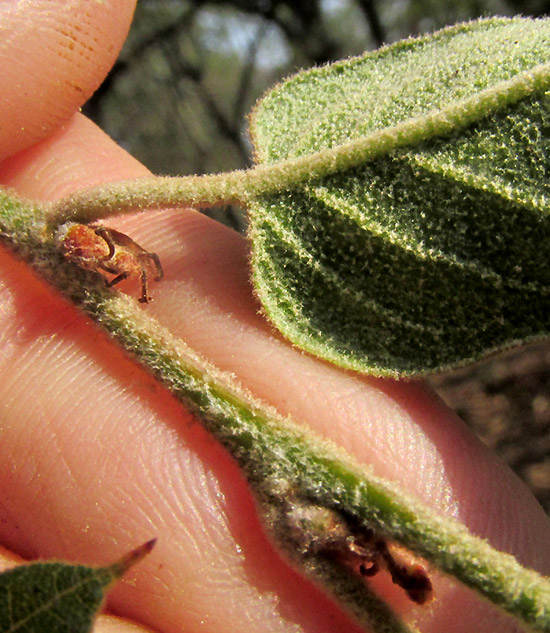
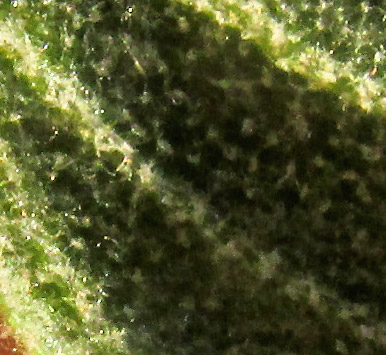
The leaves' undersurfaces were densely hairy with hairs branching from their bases -- "stellate hairs", or star-like -- seen closer-up at the right. The blade's margins were interestingly thickened and slightly turned under. Another important field mark for identifying the tree is seen in the above picture's lower-left corner: Leaf tips can be conspicuous and slender. "Can be" is written because most leaves didn't develop such tips.
In the large picture above, near the left side, notice the dark, slender items emerging from behind scales on the brownish bud. They look like slender styles tipped by stigmas, but that's not how acorns develop. I think they must be fungal reproductive bodies, the "styles" being perithecial beaks, and the "stigmas" being ostioles through which spores are released. It looks like our tree's buds were being attacked by a fungal pathogen.
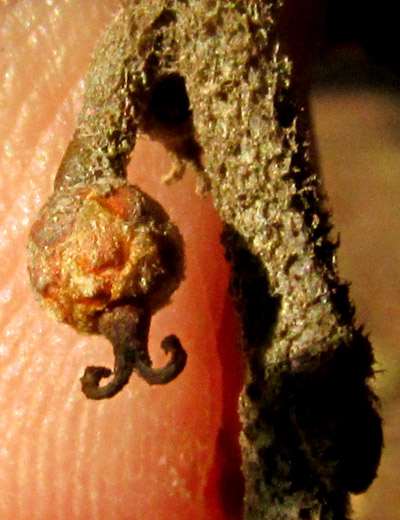
At the right you can see what the beginning of an acorn really looks like. This female flower with its thick stigmas appeared on our light-seeking tree.
 Also look how dense hairiness covers the twigs. At the right is an acorn found beneath the tree. There's a "?" in the picture because other oak species were nearby, we were on a slope, so I couldn't be 100% sure that this acorn hadn't rolled downhill from beneath another oak species. I doubt that, though.
Also look how dense hairiness covers the twigs. At the right is an acorn found beneath the tree. There's a "?" in the picture because other oak species were nearby, we were on a slope, so I couldn't be 100% sure that this acorn hadn't rolled downhill from beneath another oak species. I doubt that, though.

The above catkin, or ament, of male flowers also had fallen from the tree, but many identical aments dangled from above branches so I'm sure it belonged to our tree. The fingertip provides scale. The ament appears to be only about 4cm long, which is fairly short for an oak ament. I wonder if our tree's being relegated to the shade, and the last year's extremely long, severe dry season, encouraged relatively short aments?
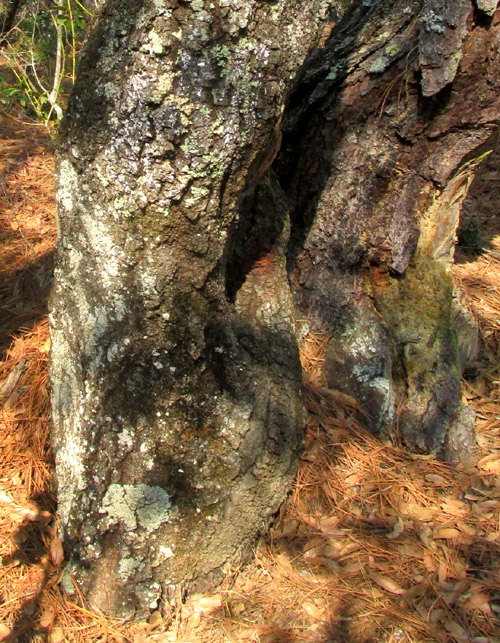
Finally, above you see the bark on our tree's trunk, and how the trunk is welded to the pine's trunk on the right. It was a difficult situation for both trees. Pines in this area are dying from bark beetles; our oak may eventually win the competition for open sky. It was sad seeing so many dying pines, not only on this hill, but in the whole region. The FAO provides insights with a page entitled Pine bark beetles of Central Mexico
Maybe about 150 oak species are found in Mexico, with some 45 documented for this upland central part of Mexico known as the Bajío Region. In this area, if you have an oak bearing leaf blades wider in their lower half than in their upper half, the leaves are around 6cm long, their undersurfaces are densely mantled with stellate hairs that are more yellowish or orangish than grayish or white, and the blade margins display no hint of lobes or teeth, though some leaves produce slender "aristate" tips, and the blades' secondary veins arise from the midveins at angles much less than 90°, you have QUERCUS x DYSOPHYLLA, with no English name.
That "x" in the name indicates that we're dealing with a hybrid. In older literature before the taxon was recognized as a hybrid, the "x" wasn't used. Nowadays sometimes authors still don't use it, though recently genetic analysis confirmed its hybrid nature, and now mostly the "x" is used. The parent species were Quercus crassipes and Quercus crassifolia.
Often offspring of hybrids are sterile, but in this case the hybrid not only was vigorous and handsome, but also able to produce offspring similar to itself, and so it went generation after generation. Today Quercus x dysophylla appears where its two parent species also exist, and sometimes where only one exists. I wonder if this unusual case of a hybrid producing generations of offspring looking like itself has anything to do with those weird items looking like stigmas atop styles?
Quercus x dysophylla is endemic just to the Mexican central uplands, from Guanajuato and here south to about Tlaxcala and the Mexico City area. The Flora del Bajío describes it as scarce, in certain areas to be regarded as vulnerable to extinction. The only uses mentioned for the hybrid are as firewood and fenceposts. However, it's clear that in general all oaks are vital members of the ecological communities they belong to, especially because of their nutritious acorns.